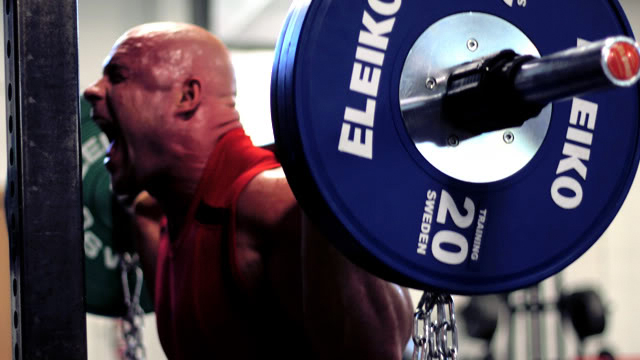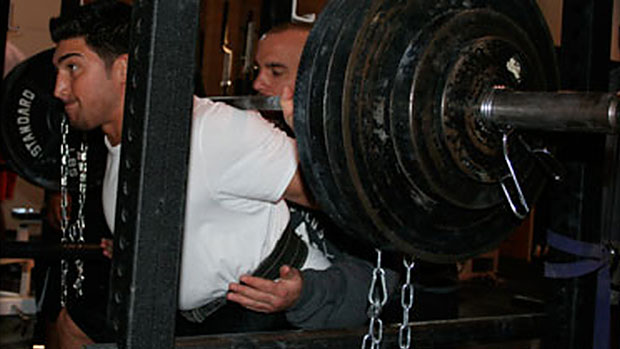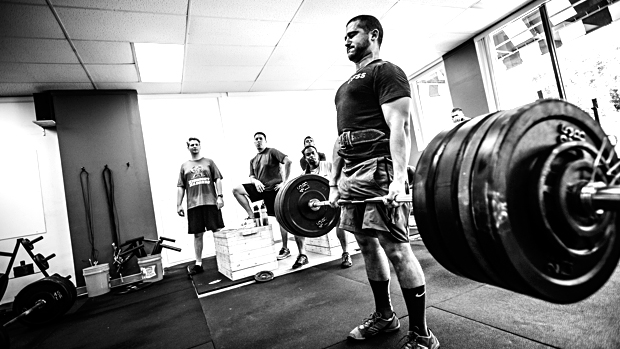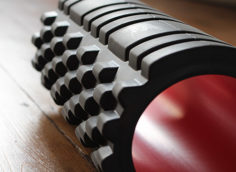Chains are highly effective for building speed, strength, and power. In fact, there isn't another "tool" I know of that you can use just once and actually see (and feel) the results in the very same training session.
Here's how they work:
- Chains (and bands) accommodate resistance.
- Chains greatly reduce the natural deceleration phase that occurs as you approach lockout.
- As you lower the bar, the chains de-load, making the weight lighter.
- As you raise the bar back to lockout, the chains reload, making the weight heavier.
- You'll find that the chains help you build both starting strength and lockout power.
- Once you've performed a few reps with chains on the bar, you'll notice that you automatically start to explode the bar up faster.
- The chains will increase your speed very quickly.
Take 50% of your max squat and perform three doubles with that weight. Next, add 20 pounds of chain to each side of the bar and do three more doubles. The results will shock you.
Even though the total weight on the bar has increased, you'll suddenly move the bar faster with the chain on than with the chain off!
Here are some other variations to play with:
- If you squat under 300 pounds, try using 10 to 15 pounds of chain per side.
- If you squat 300 to 500 pounds, try using 20 to 30 pounds of chain per side.
- If you squat over 500 pounds, experiment with 40 pounds (or more) of chain per side.
Before you attempt this, you'll need to know how to set the chains up. First up, here's a shopping list:
- Buy some heavy chain with links that measure approximately 5/8ths of an inch in diameter. These heavy chains should each be 6 feet long and weigh about 10kg (22 pounds) each. (If you need lighter chain, go for 3/8ths of an inch in diameter.)
- Buy a pair of loading chains. These are for supporting the heavier chain. Buy the lightest chain you can find that's up to the job (you'll have to use your judgment on this). Each loading chain should be 6.5 feet long.
- Buy a pair of small carabineers. You'll use these to regulate the length of the loading chains, so make sure these carabineers fit through the links of your loading chains.
- Buy a good quality carabineer for each of your heavy chains. Next, snap a carabineer on the middle link of each heavy chain. To secure each heavy chain to a loading chain, simply snap the carabineer that's on the heavy chain onto the loading chain.
- Note: Carabineers can be bought from climbing/hiking shops and chain can be obtained from hardware stores, although you'll have to shop around a bit to find heavy chain (most of the stuff available at hardware stores isn't thick enough).
Setting up the chains is straightforward, but many gym warriors and athletes alike make a huge mess of it. If you get the set-up wrong, you won't reap the benefits. So read the next part carefully.
Let's start with the easiest lift with which to assemble chains, the deadlift.

You don't need to use a loading chain to deadlift against chain weight. Simply drape the chain over the bar and you're good to go.
There are two ways you can do this:
- Put the chain over the middle of the bar and have it rest between your feet (perfect for pulling Sumo style), or...
- Put the chain on the outside of the plates on each side of the bar. If you do this, place a fat collar on after the last plate and then add the chain to the bar. You'll see why you need the fat collar when you try it.
When pulling against chains, make sure you have the chain directly under the bar or slightly behind it. The worst mistake you can make is to start pulling with the chain in front of the bar as this will pull you forward, which is a very bad thing when trying to increase your deadlift.
To set up the chain for the squat and bench press, remember what it is you're trying to achieve. Your aim is to set up the chains so that when you're in the hole of your squat, nearly all the heavy chain is on the floor. Likewise, when benching, nearly all the heavy chain should be on the floor when the bar touches the chest.
To achieve this correct height, simply adjust the length of your loading chains. This requires some trial and error the first time you do it, but once you have the correct set up for both lifts, it'll be a snap. Make sure to mark your loading chains so that you know the exact set up for both your squat and bench.
This isn't mandatory of course, although counting chain links every time you lift gets old rather quickly.
If you're training in a team/group that's made up of lifters of varying heights, set the chains for the tallest guy. Although this will mean that the set-up isn't perfect for the others, it'll be good enough.
Here's a video of yours truly squatting and deadlifting against chains. Notice how I set them up:
Here's a video showing how the chains look on the bench press:
Before using chains, it makes sense to develop your strength to a good level using just straight weights. You don't have to be world-class, but if you can't yet squat and bench press with good form or haven't yet deadlifted 315 pounds, what you really need is a decent program, some patience, and a kick in the ass, not chains.
In other words, before you start to use chains, make sure you have good technique and have built some strength using less advanced methods.
If you are ready to use chains, here's what you need to know:
- Chains can be used for speed work, maximal effort work, and repetition work. (I prefer to use them on speed and maximal effort work and use straight weight for repetition work.)
- Do not start using chains on every exercise you do. This is way too much of a good thing. Instead, choose one exercise like the bench press and add chains for 3 or 4 weeks and see how you progress.
- If you want to copy me, try using chains on your squat and perform four doubles with 50% of your max on week 1, 55% on week 2, and 60% on week 3. On week 4, remove the chains and re-test your max.
- For equipped powerlifters and athletes, chains are awesome as they'll increase speed and explosive power and make your lockout stronger.
- Raw powerlifters may use chains but must be careful to still practice their lifts with straight weight. The reason being is that raw lifters have to get the bar out of the hole on the squat and off the chest on the bench press themselves. An over-reliance on chains could build the lockout at the expense of strength at the opposite end of the movement.
Chains are a valuable tool for developing speed, strength, and power. However, they must be set up correctly to gain any real benefit, and if you're a total beginner you're just not ready for them.
However, if you have good technique and have built some strength, get yourself some chains. You have nothing to lose and could have some rapid progress to gain. If you're already pretty strong and aren't using chains in your training, you're likely missing out on some near-instant increases in strength and power!
Next up: Using bands!





